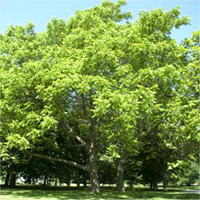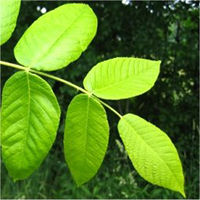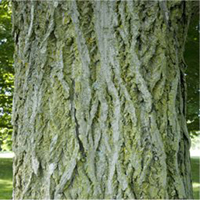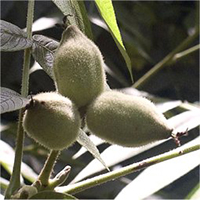Butternut (Species at Risk)
Scientific name: Juglans cinerea




Cover photos credit: Tree: Natural Resources Canada, Canadian Forest Service; Leaf: Keith Kanoti; Bark: Natural Resources Canada, Canadian Forest Service; and Fruit: Natural Resources Canada, Canadian Forest Service.
Status
Endangered
“Endangered” means the species lives in the wild in Ontario but is facing imminent extinction or extirpation.
Date added to the Species at Risk in Ontario List
The Butternut was already assessed as endangered when the Endangered Species Act, 2007 (ESA) took effect in 2008. A reassessment in November 2017 confirmed this status.
Read the assessment report [PDF].
What it looks like
Butternut is a medium-sized tree that can reach up to 30 m in height. It belongs to the walnut family and produces edible nuts in the fall. The bark of younger trees is grey and smooth, becoming ridged as it ages.
Butternut is easily recognized by its compound leaves, which are made up of 11 to 17 leaflets (each nine to 15 centimetres long) arranged in a feather-like pattern. The fruit is a large nut that contains a single seed surrounded by a light green, sticky, fuzzy husk.
Where it lives
In Ontario, Butternut is usually associated with deciduous forests, establishing under canopy openings or along forest edges. It is also found in treed fence lines. It prefers moist, well-drained soil and frequently occurs within the floodplains of streams or small rivers.
It is also found on well-drained gravel sites and rarely on dry rocky soil.
This species does not do well in the shade, and often grows in sunny openings and near forest edges.
Where it’s been found in Ontario
Butternut can be found throughout central and eastern North America. In Canada, Butternut occurs in Ontario, Quebec and New Brunswick. In Ontario, this species is found throughout the southwest, north to the Bruce Peninsula, and south of the Canadian Shield.
What threatens it
Butternut Canker is a fungal disease that spreads quickly and can kill a tree within a few years. This fungus has already had a devastating impact on North American Butternut populations.
Surveys in eastern Ontario show that most trees are infected.
Some infected Butternut trees live for many years. Experts hope this is an indication of resistance to the disease.
Action we are taking
This species and its habitat are protected under Ontario’s Endangered Species Act, 2007 (ESA).
The ESA also requires us to prepare recovery guidance for endangered species such as Lake Butternut.
All species listed on the Species at Risk in Ontario List may be eligible for consideration for government funding through the Species at Risk Stewardship Program.
Recovery strategy
A recovery strategy includes advice to the m inister on objectives for the protection and recovery of the species in Ontario and how to achieve those recommended objectives.
Read the executive summary (May 31, 2013)
Read the recovery strategy (May 31, 2013)
Government response statement
A government response statement is a policy that outlines the actions the government intends to take in response to the recommendations in a recovery strategy (or management plan) , and the government’s priorities with respect to taking those actions.
Read the government response statement (March 14, 2014)
Review of progress
A review of progress made toward protecting and recovering a species is required no later than the time specified in the species’ government response statement, or not later than five years after the government response statement is published if no time is specified.
Read the report on progress towards the protection and recovery of 16 species at risk, including Butternut (Juglans cinerea) (2019).
Habitat protection
Butternut habitat has been protected under the ESA since June 30, 2013.
Species at Risk Conservation Fund
Butternut has been designated as an eligible species for the Species at Risk Conservation Fund .
Learn how the Species at Risk Conservation Fund and the Species Conservation Action Agency is working to help protect and recover conservation fund species.
What you can do
Report a sighting
Submit your observations of species at risk to the Natural Heritage Information Centre (NHIC), which is Ontario’s conservation data centre. Join the “(NHIC) Rare Species of Ontario” project in iNaturalist to make submitting your observations quick and easy.
The Forest Gene Conservation Association is interested in learning where Butternut trees are surviving the Butternut Canker disease. For information, contact the Forest Gene Conservation Association or Ontario Woodlot Association.
Volunteer
Volunteer with your local nature club or provincial park to participate in surveys or stewardship work focused on species at risk.
Be a good steward
- Private land owners have a very important role to play in species recovery. If you find Butternut on your land, you may be eligible for stewardship programs that support the protection and recovery of species at risk and their habitats.
- Invasive species seriously threaten many of Ontario’s species at risk. To learn what you can do to help reduce the threat of invasive species, visit:
- Have a Butternut health assessment completed by a Butternut Health Expert before impacting any Butternut tree of any age, even if it is dead or dying. Apply for an ESA authorization or register for the Butternut conditional exemption if you are planning to undertake an activity that would impact a Butternut tree.
- If you are planning to log your woodlot, a certified tree marker can help you select the trees to be removed to ensure the continued health of your forest.
- Consider having a qualified professional arborist prun e or remove trees that are shading Butternut trees. This will benefit them and encourage them to produce seed . Be sure not to remove provincially rare tree species, such as those that are tracked by the Natural Heritage Information Centre. You should consult your municipal by-laws that may apply to pruning or removing trees in your area.
Report illegal activity
Report any illegal activity related to plants and wildlife to
Quick facts
- Indigenous people used Butternut medicinally to treat toothaches, injuries and digestive problems.
- There are about 13,000 Butternut in Ontario. Its scattered presence makes it difficult to do a complete inventory.